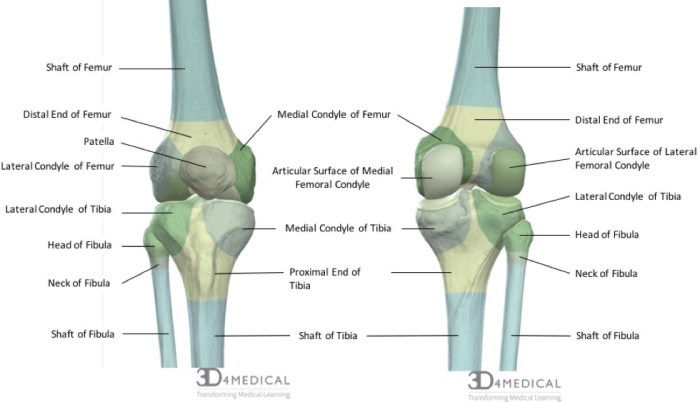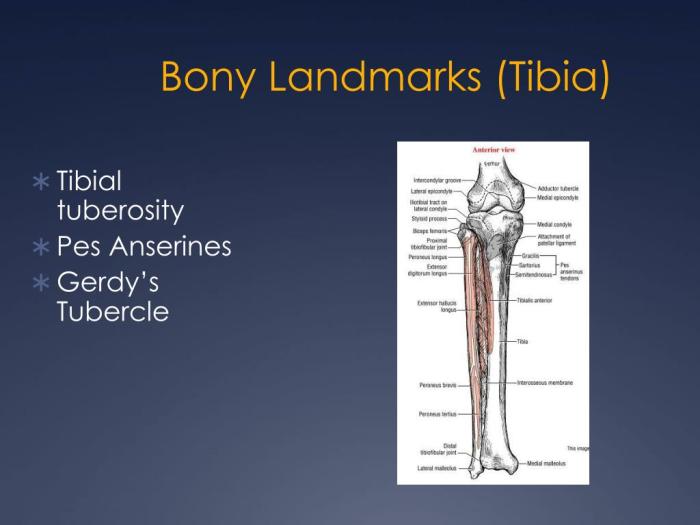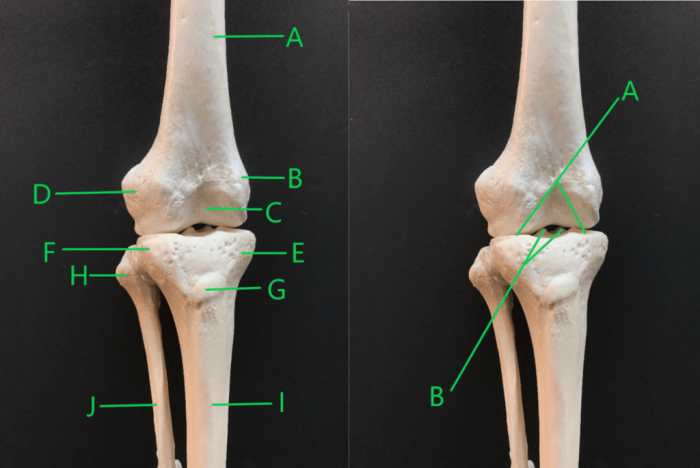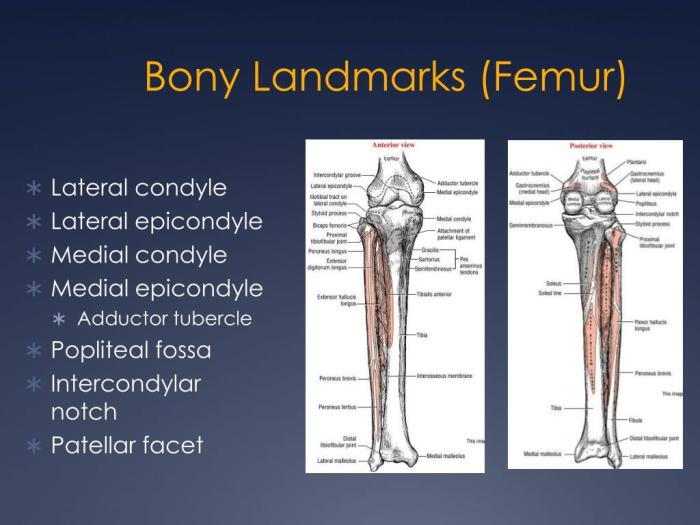Unveiling the Bony Landmarks of the Knee: An Intriguing Exploration into the Knee’s Architectural Framework
Delving into the realm of bony landmarks of the knee, we embark on an enlightening journey to unravel the intricacies of this remarkable joint. These landmarks serve as guiding stars, illuminating our understanding of knee anatomy and its profound clinical significance.
Bony Landmarks of the Knee

Understanding the bony landmarks of the knee is crucial for comprehending the anatomy and function of this complex joint. These landmarks provide reference points for surgical procedures, imaging techniques, and clinical examinations.
The knee joint is composed of three bones: the femur (thigh bone), tibia (shin bone), and patella (kneecap). Each bone features distinct bony landmarks that contribute to the joint’s stability, movement, and overall function.
Femur, Bony landmarks of the knee
- Medial and lateral condyles:Rounded projections on the distal end of the femur that articulate with the tibia.
- Intercondylar notch:A deep groove between the medial and lateral condyles that accommodates the cruciate ligaments.
- Patellar surface:A smooth, grooved surface on the anterior aspect of the femur that articulates with the patella.
Tibia
- Medial and lateral tibial plateaus:Flattened surfaces on the proximal end of the tibia that articulate with the medial and lateral condyles of the femur.
- Intercondylar eminence:A raised area between the medial and lateral tibial plateaus that separates them.
- Tibial tuberosity:A prominent projection on the anterior aspect of the tibia that serves as an attachment site for the patellar ligament.
Patella
- Apex:The pointed superior aspect of the patella.
- Base:The broad inferior aspect of the patella that articulates with the patellar surface of the femur.
- Lateral and medial facets:Smooth surfaces on the sides of the patella that glide along the femoral condyles during knee flexion and extension.
Clinical Relevance

Bony landmarks of the knee play a crucial role in clinical examination, diagnosis, and surgical procedures.
During physical examination, bony landmarks serve as reference points for assessing joint alignment, range of motion, and ligamentous stability. Palpation of these landmarks helps identify tenderness, swelling, or deformities that may indicate underlying pathology.
Surgical Approaches
Bony landmarks guide surgical approaches to the knee. The patella and tibial tubercle provide access to the anterior compartment, while the medial and lateral epicondyles facilitate approaches to the medial and lateral compartments, respectively. Surgeons use these landmarks to plan incisions and avoid damage to surrounding structures.
Medical Imaging
Bony landmarks aid in the interpretation of medical imaging studies, such as X-rays, CT scans, and MRIs. They provide anatomical context and help radiologists accurately locate and assess injuries or abnormalities. For instance, the joint line between the femur and tibia is a key landmark in evaluating joint space narrowing or osteoarthritis.
Anatomical Relationships

The bony landmarks of the knee play a crucial role in defining the anatomy and function of the joint. They interact with various anatomical structures, influencing joint stability, movement, and the surrounding tissues.
Relationship with Ligaments and Menisci
The bony landmarks provide attachment points for ligaments and menisci, which are essential for maintaining joint stability. The medial and lateral condyles serve as attachment sites for the cruciate ligaments, which prevent excessive anterior or posterior movement of the tibia.
The tibial plateau provides a stable surface for the menisci, which act as shock absorbers and contribute to joint stability.
Impact on Joint Movement
The shape and orientation of the bony landmarks influence the range and direction of knee movement. The trochlear groove of the femur allows for smooth gliding of the patella during flexion and extension. The medial and lateral condyles limit excessive varus or valgus angulation, ensuring stability during weight-bearing and movement.
Surrounding Soft Tissues and Nerves
The bony landmarks interact with surrounding soft tissues and nerves, affecting their function and susceptibility to injury. The patella and iliotibial band interact closely, with the band inserting on the lateral patella. The popliteal fossa, formed by the posterior condyles, houses the popliteal artery and vein, which can be compressed during flexion.
Comparative Anatomy
The bony landmarks of the knee exhibit significant variations across different species, reflecting their diverse evolutionary adaptations and functional requirements. Understanding these differences provides valuable insights into the evolution of the human knee and its implications for understanding human knee function and pathology.
Comparative Landmarks
In general, the basic bony components of the knee joint (femur, tibia, fibula, and patella) are present in most vertebrates. However, the specific morphology and relative proportions of these landmarks vary considerably.For instance, in quadrupedal mammals, the knee joint is typically more flexed and the patella is smaller or absent, allowing for greater range of motion in the sagittal plane.
The bony landmarks of the knee are important for understanding the anatomy and function of this joint. For instance, the patella, or kneecap, is a small bone that sits in front of the knee and helps to protect it. It is connected to the quadriceps muscle, which helps to extend the knee.
To learn more about the bony landmarks of the knee, you can take the romeo juliet act 3 quiz . This quiz will test your knowledge of the bony landmarks of the knee, as well as the muscles and ligaments that surround it.
In contrast, in bipedal humans, the knee joint is more extended and the patella is larger and more prominent, providing increased stability and load-bearing capacity.
Evolutionary Significance
These anatomical differences are directly related to the different modes of locomotion and weight-bearing patterns in different species. In quadrupedal animals, the knee joint primarily serves to provide flexibility and agility for running and jumping. In bipedal humans, the knee joint has evolved to withstand the increased weight-bearing forces and maintain stability during upright posture and walking.The
larger patella in humans acts as a sesamoid bone, increasing the leverage of the quadriceps muscle and providing additional protection for the anterior knee joint. The extended knee joint also allows for greater efficiency in energy expenditure during walking and running.
Implications for Human Health
Comparative anatomy of the knee helps us understand the unique adaptations of the human knee and the potential implications for knee function and pathology. For example, the relatively large patella in humans makes the knee joint more susceptible to patellofemoral pain syndrome and other patellar disorders.Additionally,
the extended knee joint in humans increases the risk of anterior cruciate ligament (ACL) injuries, which are more common in bipedal species than in quadrupedal animals. By understanding the comparative anatomy of the knee, we can gain insights into the evolutionary origins of these conditions and develop more effective strategies for prevention and treatment.
Educational Resources: Bony Landmarks Of The Knee

To enhance the learning experience, interactive and engaging resources can be utilized.
These resources can help students visualize and understand the complex structures of the knee joint.
Interactive Table
An interactive table can be designed to summarize the bony landmarks of the knee. This table can include columns for the name of the landmark, its location, and its clinical relevance.
Illustrations and 3D Models
A series of illustrations or 3D models can be created to demonstrate the location and relationships of the bony landmarks. These visuals can help students understand the spatial relationships between the different structures.
Teaching Module or Presentation
A comprehensive teaching module or presentation can be developed to cover the bony landmarks of the knee. This module or presentation can include interactive exercises, quizzes, and case studies to reinforce learning.
Questions and Answers
What is the significance of bony landmarks in knee anatomy?
Bony landmarks provide essential reference points for understanding the knee’s intricate structure, facilitating precise surgical interventions and accurate interpretation of medical imaging.
How do bony landmarks guide surgical approaches?
Surgeons rely on bony landmarks to plan and execute surgical procedures with greater precision, ensuring optimal outcomes and minimizing complications.
What is the clinical relevance of bony landmarks in diagnosing knee injuries?
Bony landmarks aid in identifying and localizing injuries during clinical examinations, enabling prompt and accurate diagnosis.